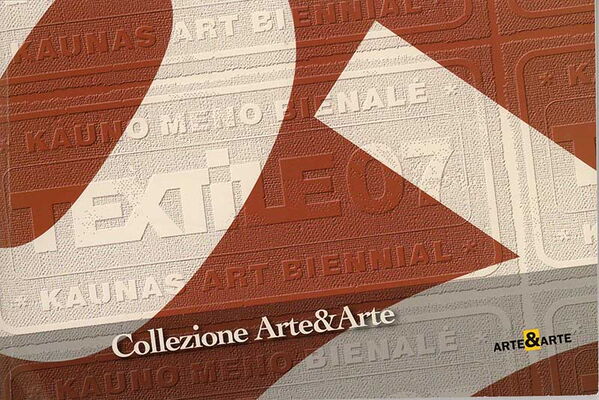2007/ 2008 - Kaunas Art Biennial TEXTILE 07
Collezione Arte&Arte, Como (Italy) Kaunas Art Biennial TEXTILE 07
Kaunas Art Biennial TEXTILE 07 MinM. Zilinskas Art Gallery Kaunas, Lithuaniai textiles: towards a tactile perception.
Virginija Vitkiene Executive Director Kaunas Art Biennial TEXTILE 07
I would like to discuss mini textiles by looking back at the sources of European miniature.
Those tiny, subtly lined images that had became established as visual stories illustrating Holy Scripture from early Middle Ages were gradually moved from the pages of the book, where not everyone could see them, onto tiny wooden panels. Thus the tradition of portable icons was born and it enhanced the laymen's belief in the possibility of a personal link with God. Seventeenth century painted miniatures were perhaps the first examples of non-sacral art designed for decorating private homes: in small scale canvases painted by 'minor Dutch painters' revealed the faith in the nobility of human spirit, beauty of everydayness and sensibility. Both kinds of miniatures had a common trait: a precise, meticulous and subtle work of the artist who attempted to reveal a religious message in one case and a humanist message in another. The small paintings were also distinguished by the spectator's relationship with the work of art. In order to perceive them the observer had not to recline his or her head (like looking at stained glass windows of the gothic cathedral) and not to look along the walls of a palace painted with frescoes, but focus their power of perception onto a small object, which is both an independent world, a tiny cosmos, a question and an answer.
In the 1960s exhibitions of mini textile arts started to be held in Western Europe and they were immediately noticed by artists and theorists as well as by audiences. It became gradually obvious that mini textiles next to the aforementioned advantages of (painted) miniatures - their ability to speak subtly about the sacral and inner world of human beings - have also the third, no less significant, tactile expression. Emphasis on materials, not so characteristic to other arts, emerges in the aesthetics of mini textiles; connotative references of fabrics or various ways of weaving enhance the uniquequality of compositions (after all, a fabric is perhaps the only material used in art which is inseparable from human existence and daily chores, birth and death, most personal experiences and memories).
The Arte & Arte collection compiled by the leaders of the organisation starting from 1991 on the basis of Miniartextile exhibitions held in Como (Italy) is among the finest examples of mini textile exhibitions in Europe. For the seventeenth year in a row a small dedicated team (Nazzarena Bortolaso, Mimmo Totaro, Luciano Caramel and recently - Paola Re), with the help of international teams of the expert jury, have compiled an exposition of half a hundred works. Most works in the collection are three-dimensional objects revealing the artists' need to construct, to string, tie, knot, weave, glue, crease or fuse various textile and non textile materials. These artists are from various countries - Italy, Poland, England, Argentina, Japan, Korea, China and other countries of the world. In the exhibitions of Kaunas Art Biennial TEXTILE 07, the partners Arte & Arte, like in the collection which will be presented in Kaunas this year, there is a clear wish, effort and unexpected results in upholding the audience's interest in textiles. It is pleasant to sense the conceptual closeness with colleagues from a geographically distanced territory who perceive a piece of textiles as an element of contemporaryart and culture, unbound by canonical restrictions on materials, techniques or expression. Therefore next to constructive compositions of mini textiles that emanate Japanese precision and aesthetics, there are plenty of metal, ceramics and glass elements in the Arte & Arte collection. And in a large format installation accompanying mini textiles exhibitions traditional means of textiles are often replaced by photographs, video projections and interactive performances.
Having visited the last Miniartextilecomo exhibition Spinning Time of the year 2007 in Como, I was fascinated by several characteristics of the Arte & Arte team, which doubtlessly guarantee an impeccable quality of curated events (a new mini textile collection every year exhibited not only in Italy, but also transported to other countries of Europe.) The first of them is a professional attitude of exhibition organisers which is remarkable not only in forming aims and criteria of exhibitions, selecting works, publishing catalogues, but also in taking care of an impeccable exhibition of each work of art (particular attention and resources have been granted to exposition and lighting). Another one is an obvious love to one's own work, textiles, ist specific expression, which inspires enthusiasm, new ideas, openness and partnerships. Travels of the Arte & Arte collections, among them to Kaunas, demonstrate an open, contemporary attitude of professionals who present it towards the processes of contemporary art and the place of textiles in them and fascinate us with the awarded opportunity for a more personal relationship with a work of art.
© Virginija Vitkiene Executive Director Kaunas Art Biennial TEXTILE 07
